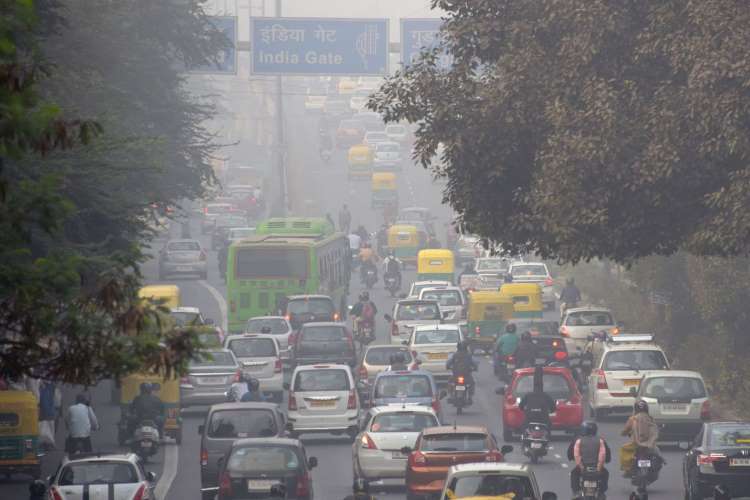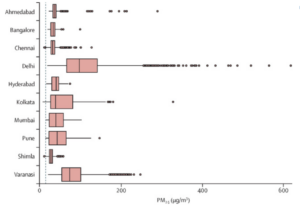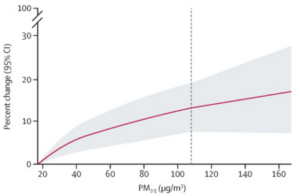
As winter approaches, India braces for the annual public health emergency triggered by extreme air pollution. Historically, the spotlight has been on Delhi where air quality plummets to hazardous levels each year. However, recent data reveal that cities and towns across India face even more dangerous levels of air pollution. Despite this growing crisis, much of the national discourse remains focused on Delhi, while smaller cities continue to suffer without adequate attention or action. To address this worsening situation, comprehensive and sustained policies are urgently needed to tackle air pollution across India, especially as winter intensifies the problem.
While Delhi remains the focus India’s air pollution discourse, many smaller cities and towns have recorded even higher levels of toxic air. Towns like Byrnihat in Meghalaya, Begusarai in Bihar, and Sri Ganganagar in Rajasthan now have air quality indices worse than the capital’s. These regions, often overlooked, suffer from industrial emissions, vehicular pollution, and poor oversight, all compounded by their geographic location and meteorological factors.
READ I Universities must reimagine their role in higher education
Air pollution beyond Delhi
For far too long, national interventions have centred around Delhi, leaving much of India’s hinterland to grapple with poor air quality without the resources or attention necessary to address the problem. The growing pollution in Tier II and Tier III cities calls for a wider rethinking of how India approaches its air pollution crisis. The battle for clean air cannot be won by focusing on a single metropolis — it demands a nationwide response that addresses pollution hotspots wherever they may emerge.
One of the reasons many cities escape scrutiny is the inadequacy of India’s current air quality standards. The National Ambient Air Quality Standards (NAAQS) set the permissible level of PM2.5 — the fine particulate matter most harmful to human health — at 40 micrograms per cubic meter. This threshold is far more lenient than the World Health Organisation’s recommended guideline of 15 micrograms per cubic meter, making it easier for many regions to appear compliant even when the air is far from safe.
Daily PM 2.5 concentrations in Indian cities

This leniency not only skews public perception but also allows for inaction in areas that desperately need intervention. If India is to tackle air pollution comprehensively, it must align its air quality standards with global best practices, ensuring that dangerous levels of particulate matter are recognised and acted upon across the country. Rural areas, where industrial emissions often go unchecked, should also be included in this reassessment. A more stringent and widespread monitoring system would provide a clearer picture of the air quality crisis and help prioritise regions that have long been ignored.
Failure of short-term solutions in Delhi
Delhi’s air pollution crisis has been exacerbated by a lack of long-term planning and over-reliance on short-term, populist measures. The odd-even vehicle rationing scheme, introduced with much fanfare, has been largely ineffective in curbing pollution levels. Moreover, the highly publicised smog towers installed in Delhi, meant to act as air purifiers, have proven to be expensive failures, offering little relief from toxic air. These piecemeal solutions, while politically expedient, have done little to address the root causes of the crisis.
Adding to the problem is the underutilisation of funds allocated to environmental projects. A right-to-information request in 2017 revealed that the Delhi government had collected nearly Rs 787 crore in environmental cess, none of which had been spent. This is symptomatic of a broader issue where political will often falls short of the financial resources available to combat air pollution.
What is more, there is a pattern of shifting blame for Delhi’s pollution onto neighbouring states. Each year, stubble burning in Punjab and Haryana contributes to the city’s toxic air, yet little is done to address this problem at its source. Instead of focusing on long-term solutions, such as promoting sustainable farming practices and providing financial incentives for farmers to manage crop residue responsibly, the issue is politicised, further delaying real action.
Health risks demand urgent attention
The health impacts of air pollution are well-documented and devastating. Delhi alone records about 12,000 deaths annually due to prolonged exposure to PM2.5, with the city’s residents potentially losing up to 12 years of life expectancy if the current levels of pollution persist. But Delhi is not alone in facing this public health catastrophe. Across India, air pollution is linked to respiratory diseases, cardiovascular conditions, and an increased risk of mortality.
Recent studies have confirmed the significant association between short-term exposure to high levels of particulate matter and daily mortality rates in Indian cities. The absence of a safe threshold for PM2.5 exposure means that even low levels of pollution can have deadly consequences. Yet, policy interventions remain limited and reactive, often implemented only after pollution levels have already spiked to dangerous levels.
Link between air pollution and mortality

The impact on children is particularly worrying. Exposure to toxic air from an early age can impair cognitive development and cause long-term respiratory issues. The health burden from air pollution is not just an urban problem; rural areas, where pollution from household stoves, agricultural practices, and unregulated industries is rampant, also face severe health consequences.
Need for comprehensive policies
India’s air pollution crisis can no longer be managed with temporary, city-specific measures. Instead, the country needs a comprehensive, long-term approach that addresses pollution at the source and implements effective solutions nationwide. This approach must focus on several key areas:
Industrial emissions are a major contributor to poor air quality, especially in smaller towns. Implementing stricter regulations and improving monitoring of emissions from factories and other industrial facilities are essential. Clean technologies should be incentivised, and industries should be held accountable for the pollution they generate.
Transportation is a leading cause of air pollution, particularly in urban areas. A robust public transportation system that reduces reliance on private vehicles would significantly lower emissions. Investments in green public transport, such as electric buses and trains, should be prioritised across all major cities, not just in Delhi.
The recurring issue of stubble burning requires urgent attention. Farmers need viable alternatives to crop residue burning, such as financial incentives for using bio-decomposers or equipment that allows for sustainable disposal of crop waste. Only through a coordinated effort between state and central governments can this annual environmental crisis be addressed.
India must align its air quality standards with global recommendations to ensure that all regions are held to the same rigorous standards of air safety. This would prevent complacency in regions that currently meet the lenient national standards but still pose significant health risks to their residents.
Public awareness campaigns must play a central role in India’s fight against air pollution. Citizens need to be informed about the health risks of poor air quality and how they can contribute to reducing pollution through simple actions like using cleaner energy for cooking, reducing waste, and opting for public transport.
India’s air pollution crisis extends far beyond the borders of Delhi, affecting millions of people across the country. Addressing this widespread problem requires a national commitment to implementing comprehensive policies that focus on long-term solutions. From stricter industrial regulations to public transport overhauls and agricultural reforms, the steps needed to tackle air pollution are clear. The question now is whether India’s political leadership can rise to the challenge and protect the health of its citizens from the toxic air they breathe.
Anil Nair is Founder and Editor, Policy Circle.

